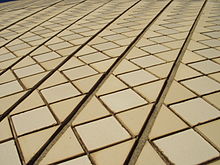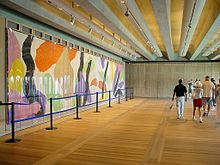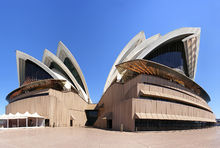Sydney Opera House
| Sydney Opera House | |
|---|---|
 Sydney Opera House (2015) |
|
| Data | |
| place | Sydney |
| architect | Jørn Utzon |
| Construction year | 1959-1973 |
| Coordinates | 33 ° 51 '22 " S , 151 ° 12' 55" E |
| particularities | |
| UNESCO world heritage | |
The Sydney Opera House ( German Opera House Sydney ) is one of the distinctive and famous buildings of the 20th century and the symbol of Sydney . It goes back to the design of the Danish architect and Pritzker architecture award winner Jørn Utzon (1918–2008).
The Sydney Opera House was inscribed on the Australian National Heritage List on July 12, 2005 and on the UNESCO World Heritage List on June 28, 2007 . Denmark now regards the opera house as part of its cultural heritage and included it in Denmark's cultural canon in 2006 . The construction costs of the opera increased by a factor of 14.3 during the construction phase and completion was delayed by several years.
Dimensions
The building is 184 meters long, 118 meters wide and covers an area of approximately 1.8 hectares. Its distinctive roof rises 67 meters high and is clad with 1,100,000 glazed, white, glossy ceramic tiles that were imported from Sweden. 580 piles , which were anchored 25 meters deep in the ground, support the structure, which weighs around 160,000 tons.
Interior design
The opera house contains five theaters with a total of 5541 seats: the Concert Hall (concert hall) with 2688 seats, the Joan Sutherland Theater (opera theater) with 1547 seats, the Drama Theater with 544 seats, the Playhouse with 398 seats and the Studio Theater with 364 seats . There are around 100 rooms in total, including five trial studios, a cinema, 60 changing rooms, four restaurants, six bars and numerous souvenir shops. The power supply would be sufficient for a city with 25,000 inhabitants and comprises 645 kilometers of electrical cables with which, among other things, more than 6000 lights are supplied with electricity.
Emergence

In the late 1940s, the idea matured in Sydney that this city should also have an opera house. A representative appearance of such a building was considered helpful.
As a construction site had Bennelong Point , preliminary of the city peninsula in the harbor on the other side of the 1,932 completed Harbor Bridge envisaged. The locality, named after an Australian native, was last used as a tram repair center, but after this form of public transport had lost out to car traffic, it had degenerated into industrial wasteland.
The originally set construction price was exceeded by fifteen times, the completion could only be realized with the help of a specially launched lottery.
The international tender, for which 233 proposals were submitted, was won in 1957 by the then renowned Danish architect Jørn Utzon , who participated outside Denmark for the first time. An international jury led by Eero Saarinen decided on his design, although strictly speaking it violated the competition rules, as it was only a rough sketch. Among other things, it was also given an honorable mention by the modernist Austro-Australian architect Harry Seidler .
From 1957 the engineer Ove Arup and his partners created the static calculations; Arup was also instrumental in the success of the project together with the engineers in his office (such as Jack Zunz and Peter Rice ).
Construction work began in 1959. However, the curved shells of the roof created major problems because they were difficult to calculate. Often new architectural territory had to be broken and problems were resolved as they arose. The design often had to be adapted to new realities. The complex geometry on the roof alone has been redesigned over twelve times in six years. Computers controlled with punch cards took 18 months to calculate the curvature and statics of all roofs. 44 draftsmen were employed to create more than 1700 plans of the roof structure.
Utzon was supposed to start the construction work before all cost analyzes and all technical problems were resolved. Therefore, neither an exact cost calculation nor planning of the construction time was possible. This contributed to the fact that the originally planned construction costs grew from £ 3.5 million to over £ 50 million (100 million Australian dollars ) and the completion date from Australia Day (January 26th) 1963 to autumn of that year 1973 delayed.
The rising construction costs, but also artistic differences led to a rift between the lead government of the Australian state of New South Wales under the conservative Prime Minister Robert Askin and the architect. Ultimately, Utzon's funds were blocked and he could no longer pay his employees. Expecting to be asked back, Utzon left his construction site in February 1966. His completely surprising departure was the climax of the public dispute. Utzon never set foot on Australian soil again.
Instead, a group of young Australian architects was hired to finish the interior. Utzon was convinced that the compromises made would ruin the work, and at the opening, critics and artists partially agreed that he was right. Above all, the cost-effective design of large parts of the interior and the acoustics were often criticized. Two thirds of the orchestra pit in the opera house (Joan Sutherland Theater) is now below the stage, as it has been moved from the large building to the smaller one.
On October 20, 1973, the opera house was officially opened by Queen Elizabeth II , the formal head of state of Australia. At the opening, Beethoven's Ninth was performed with the Ode to Joy .
As a sign of late reparation, Jørn Utzon was invited in 1999 to help with the renovation and refurbishment of the interior as a consultant. In his Danish studio, he designed a tapestry for the interior of a special room that was reopened in 2004. He dedicated the tapestry to Carl Philipp Emanuel Bach .
Opera house today
Today the Sydney Opera House is one of the most popular tourist attractions and, next to the Sydney Harbor Bridge and together with the Uluṟu (Ayers Rock), the symbol of Australia. The Sydney Opera House is one of the largest cultural centers in the world. Every year around 2500 performances and events with around four million visitors take place.
The Sydney Festival occasionally hosts free concerts and other events. Since 1978 the opera house has been regularly included as an exhibition venue in the biennial Biennale of Sydney , a three-month international exhibition festival .
modernization
Extensive renovation and redesign work began in summer 2016. Among other things, the outdoor area is currently being redesigned so that traffic is separated from pedestrians. In addition, the two main halls are being renovated. The Concert Hall will be closed from the second half of 2019 to the beginning of 2021. Among other things, the acoustics should be improved here. Before that, the Joan Sutherland Theater was closed from May to December 2017 to modernize the technology.
literature
- O. Arup, RS Jenkins: The evolution of the design of the concourse at the Sydney Opera House , Proc. Inst. Civil Eng., Vol. 39, April 1968, pp. 541-565
- Bent Flyvbjerg: Design by Deception. The Politics of Megaproject Approval. In: Harvard Design Magazine, Volume 22, Spring / Summer 2005, ( PDF file , 4.43 MB).
- James Semple Kerr: Sydney Opera House. An Interim Plan for the Conservation of the Sydney Opera House and its Site. Sydney, 1993, ISBN 978-0-90965-411-5
- Anne Watson (Ed.): Building a Masterpiece. The Sydney Opera House. Lund Humphries, 2006, ISBN 978-0-85331-941-2
Movies
- The Sydney Opera House, Australia. Documentation, Germany, 2008, 14:17 min., Written and directed: Werner Meyer, production: SWR , series: Treasures of the World , film text & video .
- Sydney's Opera House. Landmark of an unknown star architect. (OT: Skyer: Jørn Utzon. ) Documentary, Denmark, 1994, 51 Min, written and directed. Pi Michael, production: Fakta, German-speaking First broadcast: October 20, 2013 in SRF 1 , Row: Auspicious Art , Summary of SRF1, Movie data from WorldCat .
Web links
- Entry on the UNESCO World Heritage Center website ( English and French ).
- Official site of the Sydney Opera House (English)
- Sydney Opera House at Google Cultural Institute
- Interactive panoramas from the Sydney Opera House
Individual evidence
- ↑ a b environment.gov.au : Sydney Opera House, New South Wales, in English, accessed November 1, 2011.
- ^ Sydney Opera House. (No longer available online.) In: Opera Theater Officially Renamed Joan Sutherland Theater. Sydney Opera House, October 16, 2012; Archived from the original on October 18, 2012 ; accessed on October 19, 2012 (English). Info: The archive link was inserted automatically and has not yet been checked. Please check the original and archive link according to the instructions and then remove this notice.
- ^ Opera House theater to be renamed after Sutherland (English) . In: ABC News , Australian Broadcasting Corporation. Retrieved October 17, 2012.
- ^ Ove Arup: Sydney Opera House, 1957–1973
- ^ A b c d e f Film text from "The Sydney Opera House, Australia" , SWR , 2008
- ↑ Spice News Australia: Sydney Opera House to recreate 1973 opening , August 8, 2013
- ↑ kae / dpa: Sydney Opera House : Most famous building in Australia is being radically rebuilt. In: http://www.spiegel.de . Spiegel Online, August 11, 2016, accessed August 28, 2016 .
- ^ Renewal. In: http://www.sydneyoperahouse.com/ . Sydney Opera House, accessed August 28, 2016 .








